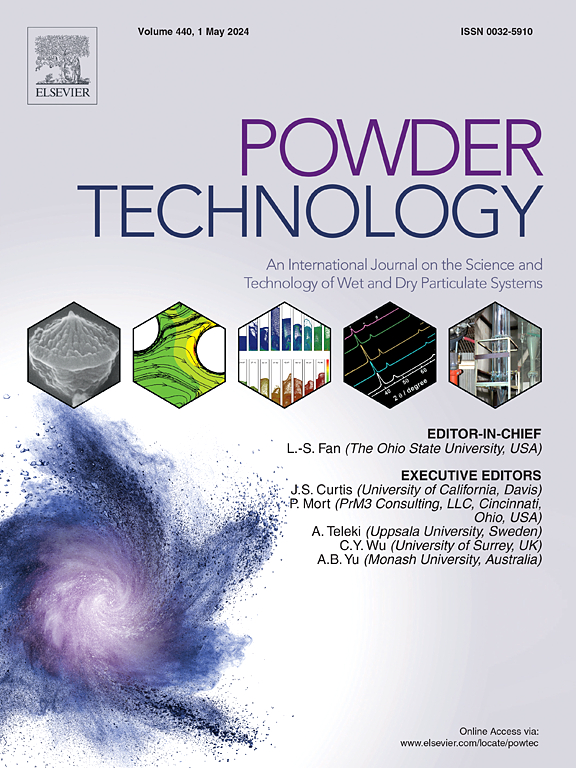Investigation of mechanism on capturing aerosol droplets of fibrous media by CFD-DEM: Effects of pore volume and suction force
IF 4.5
2区 工程技术
Q2 ENGINEERING, CHEMICAL
引用次数: 0
Abstract
The capture of aerosol droplets by fibrous media is an important technique for controlling airborne pollutants. This study mainly aimed to investigate the mechanism of aerosol droplet capture by fibrous media and the effects of pore volume and the suction force acting on the liquid bridge, by means of the computational fluid dynamics–discrete element method (CFD-DEM). In this paper, a dynamic model was constructed for the capture of aerosol droplets by fibrous media, and the processes of liquid film on the surface and interior of fibrous media were simulated to form and destroy the liquid film. The results demonstrated that capture efficiency was significantly influenced by solid volume fraction (SVF) and fluid velocity. The pore volume decreased with an increase in SVF, and the liquid bridge between aerosol droplets was shortened, which prevented the bridge from becoming concave because of a drop in capillary force. The suction force decreased as the fluid velocity increased and the capillary pressure acting on the liquid bridge decreased, leading to the rupture of the bridge. Larger aerosol droplets were easily captured by fibers but not by liquid films. The dominant capture mechanisms were interception and collision. These conclusions could be used to investigate the mechanism of aerosol droplet trapping and influencing factors on capture efficiency of fibrous media in the control of aerosol droplets.

基于CFD-DEM的纤维介质气溶胶液滴捕获机理研究:孔隙体积和吸力的影响
纤维介质捕获气溶胶液滴是控制大气污染物的一项重要技术。本研究主要采用计算流体力学离散元法(CFD-DEM)研究纤维介质对气溶胶液滴的捕获机理以及孔隙体积和吸力对液桥的影响。本文建立了纤维介质捕获气溶胶液滴的动力学模型,模拟了纤维介质表面和内部液膜形成和破坏的过程。结果表明,固体体积分数(SVF)和流体速度对捕集效率有显著影响。孔隙体积随着SVF的增大而减小,气溶胶液滴之间的液桥缩短,防止了由于毛细力的降低而导致液桥凹化。吸力随着流体速度的增大而减小,作用在液桥上的毛细压力减小,导致液桥破裂。较大的气溶胶液滴很容易被纤维捕获,但不能被液体薄膜捕获。主要的捕获机制是拦截和碰撞。这些结论可用于研究气溶胶液滴捕获机理以及纤维介质在气溶胶液滴控制中的捕获效率影响因素。
本文章由计算机程序翻译,如有差异,请以英文原文为准。
求助全文
约1分钟内获得全文
求助全文
来源期刊

Powder Technology
工程技术-工程:化工
CiteScore
9.90
自引率
15.40%
发文量
1047
审稿时长
46 days
期刊介绍:
Powder Technology is an International Journal on the Science and Technology of Wet and Dry Particulate Systems. Powder Technology publishes papers on all aspects of the formation of particles and their characterisation and on the study of systems containing particulate solids. No limitation is imposed on the size of the particles, which may range from nanometre scale, as in pigments or aerosols, to that of mined or quarried materials. The following list of topics is not intended to be comprehensive, but rather to indicate typical subjects which fall within the scope of the journal's interests:
Formation and synthesis of particles by precipitation and other methods.
Modification of particles by agglomeration, coating, comminution and attrition.
Characterisation of the size, shape, surface area, pore structure and strength of particles and agglomerates (including the origins and effects of inter particle forces).
Packing, failure, flow and permeability of assemblies of particles.
Particle-particle interactions and suspension rheology.
Handling and processing operations such as slurry flow, fluidization, pneumatic conveying.
Interactions between particles and their environment, including delivery of particulate products to the body.
Applications of particle technology in production of pharmaceuticals, chemicals, foods, pigments, structural, and functional materials and in environmental and energy related matters.
For materials-oriented contributions we are looking for articles revealing the effect of particle/powder characteristics (size, morphology and composition, in that order) on material performance or functionality and, ideally, comparison to any industrial standard.
 求助内容:
求助内容: 应助结果提醒方式:
应助结果提醒方式:


